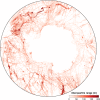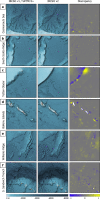The International Bathymetric Chart of the Southern Ocean Version 2
- PMID: 35672417
- PMCID: PMC9174482
- DOI: 10.1038/s41597-022-01366-7
The International Bathymetric Chart of the Southern Ocean Version 2
Abstract
The Southern Ocean surrounding Antarctica is a region that is key to a range of climatic and oceanographic processes with worldwide effects, and is characterised by high biological productivity and biodiversity. Since 2013, the International Bathymetric Chart of the Southern Ocean (IBCSO) has represented the most comprehensive compilation of bathymetry for the Southern Ocean south of 60°S. Recently, the IBCSO Project has combined its efforts with the Nippon Foundation - GEBCO Seabed 2030 Project supporting the goal of mapping the world's oceans by 2030. New datasets initiated a second version of IBCSO (IBCSO v2). This version extends to 50°S (covering approximately 2.4 times the area of seafloor of the previous version) including the gateways of the Antarctic Circumpolar Current and the Antarctic circumpolar frontal systems. Due to increased (multibeam) data coverage, IBCSO v2 significantly improves the overall representation of the Southern Ocean seafloor and resolves many submarine landforms in more detail. This makes IBCSO v2 the most authoritative seafloor map of the area south of 50°S.
© 2022. The Author(s).
Conflict of interest statement
The authors declare no competing interests.
Figures







References
-
- Cunningham, S. A., Alderson, S. G., King, B. A. & Brandon, M. A. Transport and variability of the Antarctic Circumpolar Current in Drake Passage. J. Geophys. Res. 108, 10.1029/2001JC001147 (2003).
-
- Frölicher TL, et al. Dominance of the Southern Ocean in Anthropogenic Carbon and Heat Uptake in CMIP5 Models. Journal of Climate. 2015;28:862–886. doi: 10.1175/JCLI-D-14-00117.1. - DOI
-
- Silvano A, et al. Recent recovery of Antarctic Bottom Water formation in the Ross Sea driven by climate anomalies. Nature Geoscience. 2020;13:780–786. doi: 10.1038/s41561-020-00655-3. - DOI

